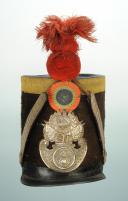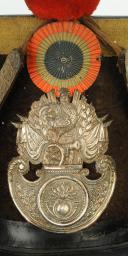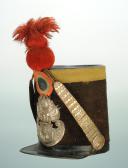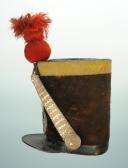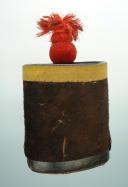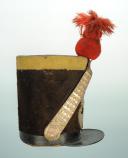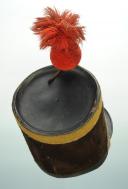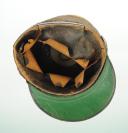
SHAKO DE SOUS-OFFICIER DE LA GARDE NATIONALE, MODÈLE 1830, MONARCHIE DE JUILLET.
Sold out
NON-COMMISSIONED OFFICER SHAKO OF THE NATIONAL GUARD, MODEL 1830, JULY MONARCHY.
Body made of cardboard covered with silk fabric, 23 cm high, edged with a 3.4 cm wool jonquil braid at the top and a black waxed leather visor. Black waxed crown with a diameter of 18 cm. Leather visor black on the outside and green on the inside.
Metal cockade, painted in tricolor, stamped with a radiant sun, diameter 6.9 cm.
High-quality silver-plated copper plate of the 1830 type, embossed with a radiant sun with in the forefront the Gallic rooster perched on a cannon surrounded by a bundle of flags and laurel branches. At the bottom, a shield richly decorated with beaded framing rods ending in acanthus leaves; in the center of the shield is a medallion with a hunting horn and flaming bomb framed by oak branches. Height of the plate 13.7 cm, width 10.3 cm.
Leather jugulars coated with black velvet covered with a silver-plated copper plate embossed in scalloped scale shapes. Round rosette stamped in its center with a hunting horn with a flaming bomb on a sanded background bordered by a protruding molding (diameter 4 cm). Jugular length 21.5 cm.
Black waxed calfskin interior lining cut into wolf teeth. Black printed paper label with the emblem and name of the manufacturer "THEZARD master hatter rue de la Cathédrale in Bayeux".
Scarlet wool flame pompom.
Very good condition.
France.
July Monarchy.
PROVENANCE:
Former collection of Hippolyte Marie-Joseph Boivin (Guermantes, September 8, 1857, Bouvresse June 19, 1912).
This scholar from the late 19th century assembled a collection of patriotic faience of great importance, which was exhibited several times in French museums.
With a collector's temperament, Hippolyte Boivin gathered faience from Rouen, Marseille, Strasbourg, Delft, Nevers, enamel dial watches from the First Empire, ancient members, Normandy and Picardy wardrobes and clocks, various period trunks and clocks, tapestries, noisemakers from all over France and even abroad.
His grandson recounts that H. Boivin and his wife traveled from village to village, buying all objects they found of interest. These acquisitions enriched his own collections and those of the museum in Beauvais of which he was the curator from 1889 to 1912. In this collecting endeavor, he also developed a passion for military memorabilia, mainly headgear, copperware, bridle bits, and various historical souvenirs.
He had a gallery built in his garden to house his military collections, which were later displayed in the "Boivin Room" at the Dejean barracks (Amiens), destroyed during the Second World War. Hippolyte Boivin showed a preference for patriotic faience by reproducing through drawing and watercolor the pieces he had collected. Two motifs may explain this attraction: firstly, his family's exile from Champagne during the German invasion of 1870 may have instilled in him a taste for patriotic and military objects; secondly, his maternal grandfather's occupation as an operator of a stoneware pottery factory in La Chapelle-aux-Pots may have fostered his interest in ceramics.
The objects constituting the collection of this enlightened amateur were all acquired based on opportunities encountered "in the field," moreover, given the collection period: from the fall of Napoleon III until the eve of the Great War, their homogeneity has been particularly preserved.
Body made of cardboard covered with silk fabric, 23 cm high, edged with a 3.4 cm wool jonquil braid at the top and a black waxed leather visor. Black waxed crown with a diameter of 18 cm. Leather visor black on the outside and green on the inside.
Metal cockade, painted in tricolor, stamped with a radiant sun, diameter 6.9 cm.
High-quality silver-plated copper plate of the 1830 type, embossed with a radiant sun with in the forefront the Gallic rooster perched on a cannon surrounded by a bundle of flags and laurel branches. At the bottom, a shield richly decorated with beaded framing rods ending in acanthus leaves; in the center of the shield is a medallion with a hunting horn and flaming bomb framed by oak branches. Height of the plate 13.7 cm, width 10.3 cm.
Leather jugulars coated with black velvet covered with a silver-plated copper plate embossed in scalloped scale shapes. Round rosette stamped in its center with a hunting horn with a flaming bomb on a sanded background bordered by a protruding molding (diameter 4 cm). Jugular length 21.5 cm.
Black waxed calfskin interior lining cut into wolf teeth. Black printed paper label with the emblem and name of the manufacturer "THEZARD master hatter rue de la Cathédrale in Bayeux".
Scarlet wool flame pompom.
Very good condition.
France.
July Monarchy.
PROVENANCE:
Former collection of Hippolyte Marie-Joseph Boivin (Guermantes, September 8, 1857, Bouvresse June 19, 1912).
This scholar from the late 19th century assembled a collection of patriotic faience of great importance, which was exhibited several times in French museums.
With a collector's temperament, Hippolyte Boivin gathered faience from Rouen, Marseille, Strasbourg, Delft, Nevers, enamel dial watches from the First Empire, ancient members, Normandy and Picardy wardrobes and clocks, various period trunks and clocks, tapestries, noisemakers from all over France and even abroad.
His grandson recounts that H. Boivin and his wife traveled from village to village, buying all objects they found of interest. These acquisitions enriched his own collections and those of the museum in Beauvais of which he was the curator from 1889 to 1912. In this collecting endeavor, he also developed a passion for military memorabilia, mainly headgear, copperware, bridle bits, and various historical souvenirs.
He had a gallery built in his garden to house his military collections, which were later displayed in the "Boivin Room" at the Dejean barracks (Amiens), destroyed during the Second World War. Hippolyte Boivin showed a preference for patriotic faience by reproducing through drawing and watercolor the pieces he had collected. Two motifs may explain this attraction: firstly, his family's exile from Champagne during the German invasion of 1870 may have instilled in him a taste for patriotic and military objects; secondly, his maternal grandfather's occupation as an operator of a stoneware pottery factory in La Chapelle-aux-Pots may have fostered his interest in ceramics.
The objects constituting the collection of this enlightened amateur were all acquired based on opportunities encountered "in the field," moreover, given the collection period: from the fall of Napoleon III until the eve of the Great War, their homogeneity has been particularly preserved.
Reference :
5668
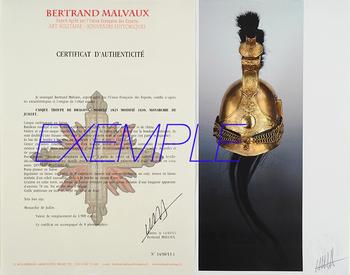
Next update Friday, april 4th at 1:30 PM
FOR ALL PURCHASES, PAYMENT IN MULTIPLE CHECKS POSSIBLE
bertrand.malvaux@wanadoo.fr 06 07 75 74 63
An authenticity certificate of the item including the description published on the site, the period, the sale price, accompanied by one or more color photographs is automatically provided for any item priced over 130 euros. Below this price, each certificate is charged 5 euros.
Only items sold by me are subject to an authenticity certificate, I do not provide any expert reports for items sold by third parties (colleagues or collectors).
